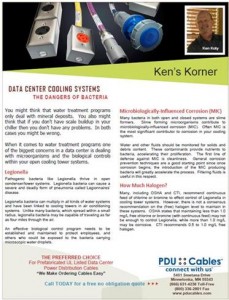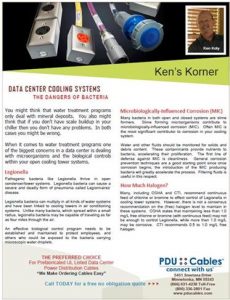KEN'S KORNER - Dangers of Bacteria 1
The Dangers of Bacteria in a Data Center Cooling System
When it comes to water treatment programs, one of the biggest concerns in a data center is dealing with microorganisms and the biological controls within your open cooling tower systems.
Why you ask? Because of the dangers of bacteria!
Legionella
Pathogenic bacteria, like Legionella, thrive in open condenser/tower systems. Legionella bacteria can cause a severe and deadly form of pneumonia called Legionnaires’ disease. Legionella bacteria can multiply in all kinds of water systems and have been linked to cooling towers in air conditioning systems. Unlike many bacteria, which spread within a small radius, legionella bacteria may be capable of traveling as far as four miles through the air.
An effective biological control program needs to be established and maintained to protect employees and others who could be exposed to the bacteria carrying microscopic water droplets.
Microbiologically-Influenced Corrosion (MIC)
Many bacteria in both open and closed systems are slime formers. Slime forming microorganisms contribute to microbiologically-influenced corrosion (MIC). Often MIC is the most significant contributor to corrosion in your cooling system.
Water and other fluids should be monitored for solids and debris content. These contaminants provide nutrients to bacteria, accelerating their proliferation. The first line of defense against MIC is cleanliness. General corrosion prevention techniques are a good starting point, since once corrosion begins; the introduction of the MIC producing bacteria will greatly accelerate the process. Filtering fluids is useful in this respect.
Organic Masses
When bio-film, slime and inorganic and organic materials come together, they form an organic mass. When free floating, organic masses can blind sensors, block water flow, and compromise your systems ability to cool critical equipment on your raised floor.
The following guidelines provide a plan for minimizing bacteria problems in cooling towers and evaporative condensers.
- Clean tower and disinfect before start-up, especially new system start-up, and after any long shutdown period (greater than 2 to 4 weeks).
- Treat water for control of corrosion, scale, fouling and microorganisms.
- Establish a maintenance plan and log all activities, including the chemical treatment program’s dosages, services and results.
- Maintain all drift (mist) eliminators in efficient and proper operating condition as well as the operations of fans that affect drift productions.
- If dead legs in the piping system exist and cannot be removed, blow them down regularly – particularly after biocide treatments and cleanings.
- Exercise all valves in the system periodically by opening and closing them fully.
- Clean the basin when slime, algae, or dirt are visible.
- Blow down direct free cooling (chilled water) risers weekly.
- Thoroughly flush and clean the entire system at least once (preferably twice) a year – and include an oxidizing disinfection before and after each cleaning.
- When a cooling tower is out of use, it should be drained and kept dry.
How much halogen?
Many, including OSHA and CTI, recommend continuous feed of chlorine or bromine to effect control of Legionella in cooling tower systems. However, there is not a consensus recommendation on the (free) halogen level to maintain in these systems. OSHA states that maintaining less than 1.0 mg/L free chlorine or bromine (with continuous feed) may not be enough to control Legionella, while more than 1.0 mg/L may be corrosive. CTI recommends 0.5 to 1.0 mg/L free halogen.
Ken Koty
P.S. I’d like to thank Steve Blumke and our friends at Fremont Industries for helping create this article on the dangers of bacteria in a data center cooling system.
For a link to Fremont Industries website


